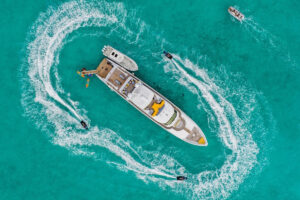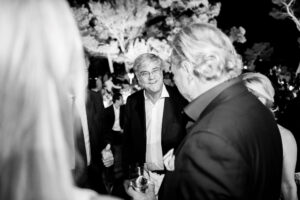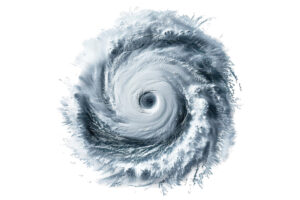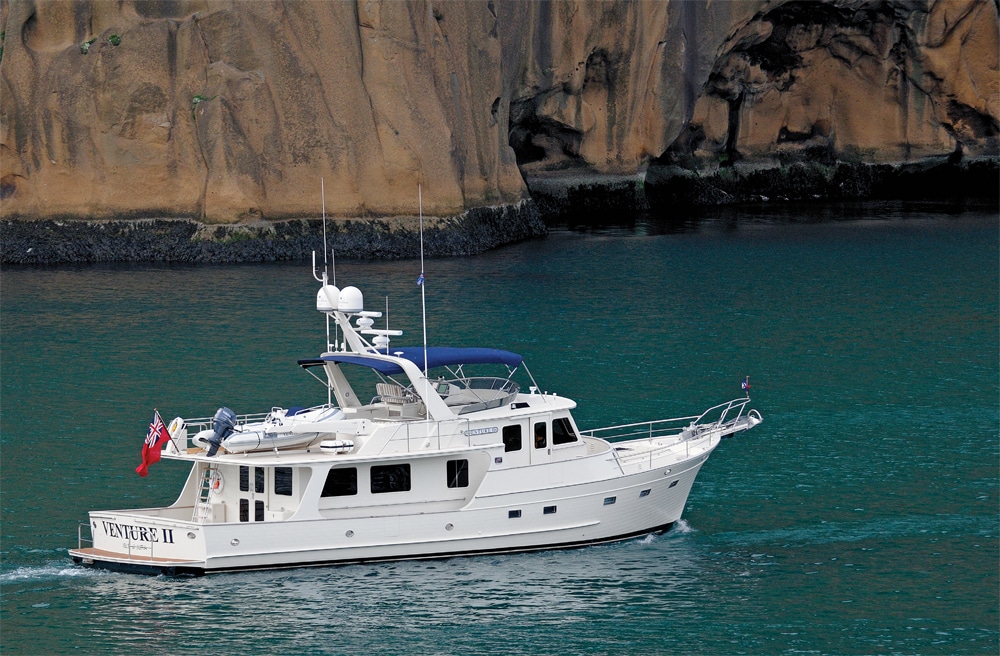
Cruising From Scotland to Iceland
The winds were blowing a steady 30 knots off our port bow. The seas had increased to 10 feet, and they were square shaped, blown toward us against the current and breaking on the tops of large ocean swells. Every once in a while there would be nothing but 20 feet of empty air below the forward sections of our 135,000-pound Fleming 65, and we would hit the ice-cold seas below us with a bone-jarring blow.
Holding on next to me in the pilothouse was Tony Fleming, the man responsible for designing and building these highly regarded yachts. “Well, this is exactly why we build them the way we do,” he said calmly in his understated British sort of way. We were in the North Atlantic, halfway between the Faroe Islands and Iceland, and as Fleming described it, “Water was coming through the bow chocks and striking the windshield like a fire hose. These were probably the worst conditions we have ever experienced during all our thousands of miles of cruising on Venture I and II.”
We were headed to Vestmannaeyjar in the Westman Islands, located 10 miles off the southern coast of Iceland aboard Fleming’s personal boat. Slowing to 7½ knots, we endured another 12 hours of foul conditions before finding protection in the lee of the Westman archipelago. A quick survey found only a broken wineglass and bottle of beer. While we had been uncomfortable, we always had faith in our little ship.
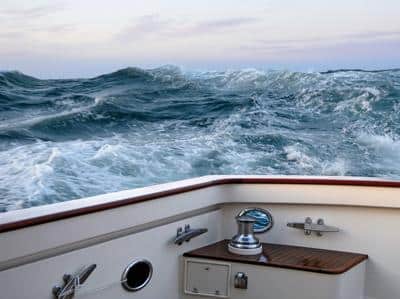
Eighteen months earlier Fleming had planned his trip to Iceland as part of an ambitious exploration of Western Europe. After a round-trip voyage from Southampton, England, to Düsseldorf, Germany, last winter, he set out to explore the Western Isles of Scotland before heading to Iceland. In April 2010, he and his captain, Chris Conklin, left Southampton for their 2,200-mile voyage to Reykjavik and beyond.
Adventurers give different reasons for their daring deeds, but those who voyage the open seas are usually drawn by the intense solitude of being hundreds of miles from land and the challenge that comes from absolute self-sufficiency. Tony Fleming, on the other hand, has other reasons for his cruising adventures.
At the age of 75, and retired from his everyday duties of boatbuilding, Fleming explains, “My reasons for cruising are primarily to visit people and places of interest, preferably those that are impossible or difficult to get to by conventional transport.” An avid filmmaker for most of his life, he documents each voyage by shooting and producing high-definition videos distributed on the company’s website (flemingyachts.com).
I joined Fleming in Stornoway, a small, friendly town on the beautiful Isle of Lewis, part of Scotland’s Outer Hebrides. Venture II was tied to a floating dock used by a local cruise ship. A quick look around the harbor revealed mostly commercial fishing vessels and a few well-equipped sailboats hailing from European countries. The Fleming 65 was by far the largest pleasure powerboat in the harbor and too big to fit in the nearby marina.
In fact, Fleming saw few large powerboats while cruising throughout Western Europe. “It seems most extensive cruising continues to be done on sailboats, but many of these people are getting a bit old to handle these boats. I’m not sure if many Europeans are familiar with the capabilities of larger, longrange powerboats such as ours.”
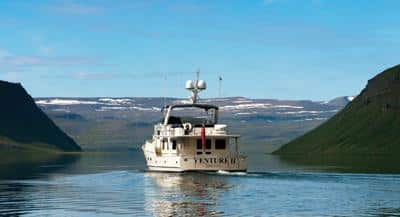
Indeed, the lack of transient dock space and adequate electrical service raises the age-old question of what comes first, the chicken or the egg. Fleming and I met with Iain Macleod, the chairman of Stornoway’s Port Authority, who showed us the city’s plans to expand its small marina to accommodate larger powerboats. But funding for the project is questionable, and the city is not sure there would be enough visiting yachts to pay for such an investment. Stornoway’s limited marina facilities reflect much of what Fleming experienced throughout England and Scotland.
Our first destination after leaving Stornoway was the Faroe Islands, 250 miles north at 62.00 N, 400 miles from Iceland. As we passed the tip of Lewis, our crew of four settled into our ocean passage routine, establishing a two-hours-on-and-six-hours-off watch system. The seas were confused, but running only six feet, eventually decreasing to three feet. After an enjoyable 26- hour passage, we arrived in Torshavn, where the harbor master assigned us space in the center of town across from a delightful collection of coffeehouses, pubs, cafes and hotels.
Again being on the largest private motoryacht in the harbor, we found ourselves the object of much curiosity. Several folks stopped by to inquire about Venture, often expressing their surprise that such a voyage could be done on a powerboat. Indeed, we were surrounded by other adventurers on their way to Iceland and beyond, but all on rugged, well-equipped sailboats.
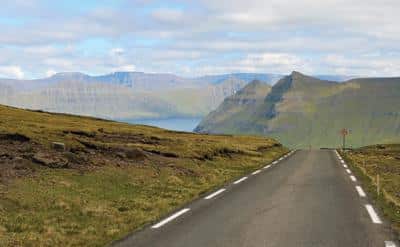
Until I agreed to join Fleming on this voyage, I had never heard of the Faroe Islands, but this archipelago of 18 islands was a highlight of our voyage. Under control of Denmark, but not part of the European Union, all but one of the islands are inhabited. Most impressive is the system of roads and tunnels connecting 80 percent of the population, which is spread over 540 square miles. Fast ferries connect the remaining islands, and there’s even reliable bus transportation between municipalities. What was once a number of decentralized villages relying on agriculture has become a connected society supporting itself on commercial fishing, fish farming and, to an ever-growing extent, tourism.
We rented a car and spent nearly a week exploring the islands. Rugged and rocky, the terrain is mostly treeless, formed by basalt lava. Originally settled by Irish Monks, the Vikings later colonized the islands. There is a joke among Icelanders that the Faroese are descendants of the Vikings who got seasick on their way to Iceland and jumped ship. Today, the population has grown to 50,000, and while Faroese is the first language, we found most people spoke English.
Kneeling in a field of flowers, in the village of Noródepil, while I composed a photo, I was approached by a large, friendly looking fellow who introduced himself as Zacharias. He lived across the street, and he invited me home to share a bowl of his wife’s “very strong Viking soup.” Zach was a documentary filmmaker on his way to Greenland to shoot a TV series, and he and his wife were most gracious, eager to talk about their Faroese way of life. The Viking soup, a blend of fish, lamb and cabbage, was delicious.
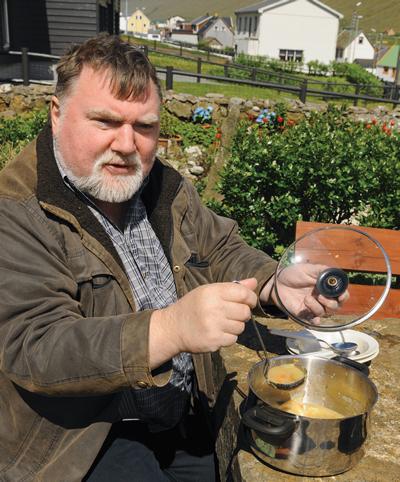
While we could have stayed in the Faroes for weeks, our schedules required us to set course for Iceland, 400 miles to the northwest, and this is where we encountered high winds and the violent, square shapes of these rougher seas. After 40 hours, when we finally found calmer conditions off Vestmannaeyjar, we could now see the mainland of Iceland. Using nautical charts and land maps, we were able to approximate our position to Eyjafjallajökull (don’t even attempt to pronounce it), the site of Iceland’s recent volcanic eruption. Looking through a supertelephoto lens from five miles offshore, I saw the eerie sight of steam and/or ash rising from the cloud-drenched mountains with Eyjafjalla glacier nearby.
Entering the harbor in Heimaey, Vestmannaeyjar, was a heart-stopper, because a jetty of lava obstructed part of the entrance, creating a narrow, twisting passageway between the high cliffs and black lava shore.
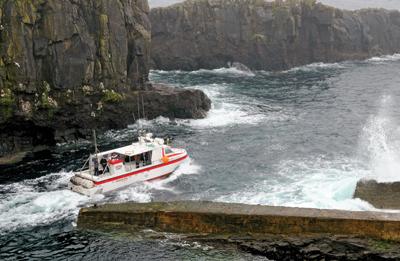
The village of Heimaey was partially destroyed during a volcanic eruption in 1973, but thanks to the heroics of the fishing fleet, everyone was safely evacuated to the mainland. The fleet returned to pump millions of gallons of seawater per day onto the advancing lava flow, finally stopping it before it sealed the harbor forever.
Heimaey is a busy commercial fishing port, complete with oceangoing trawlers and wall-to-wall fish-packing plants. Indeed, this tiny village supplies Iceland with more than 12 percent of its seafood. While the population was friendly and we had a comfortable berth on a floating dock, the odor from the fish plants was too much. With watery eyes and queasy stomachs, we departed two days after our arrival and headed for Reykjavik, 130 miles to the west. Taking a 20-mile detour to the south, we passed the island of Surtsey, which did not exist prior to 1963, when the seas started emitting gases from the ocean floor and a volcano began a three-year eruption. The only ones allowed to land on this dramatically stark island are a handful of scientists studying the process of natural colonization.
Rounding southwest Iceland, we arrived in Reykjavik and under instructions from the harbor master tied up at a small yacht club surrounded by a massive construction site. Again we were the only sizable powerboat in sight except for a fleet of commercial tour boats. As we relaxed watching the busy harbor before the sun finally dipped below the horizon at midnight, we began to grasp what a unique experience we were having. Here we were in Reykjavik, Iceland, at 64.08 N, and we had arrived on a private yacht – a motoryacht in fact – which seemed, at least to many outsiders, to be quite a remarkable achievement.
With a population of nearly 200,000 in the greater metropolitan area, Reykjavik is a busy, sophisticated city known for its fine cuisine, nightlife and beautiful women. (Conklin and I decided that the Vikings must have taken only the finest females when they raided the Nordic countries.)
Exploring the countryside by car, we were fascinated by the lush farmlands, towering waterfalls, natural hot springs and beautiful Icelandic horses, all of which were juxtaposed by acres of ominous moonscape, lava and ash-laden fields of dead flora. Attempting to drive closer to Eyjafjallajökull, we were forced to turn back by a dangerous ash cloud that had suddenly formed in high winds. The ash covered everything in sight, including the crushed lava path we were on, causing a total “gray-out.”
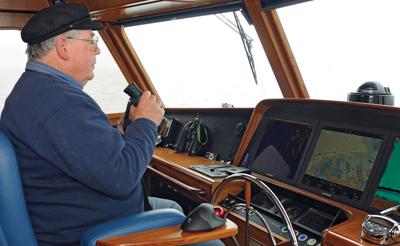
Tony Fleming continued his voyage on Venture II, circumnavigating Iceland and crossing the Arctic Circle while visiting Grimsey Island, the northernmost inhabited island of Iceland. After a lifetime of building yachts, he is now inspiring others to follow in his wake. One of his blogs states, “A yacht offers a means of travel like none other. While continuing to live in familiar surroundings, it allows you to draw aside a curtain and glimpse, if only briefly, ways of life outside your own which in turn makes you a wiser and more understanding person. The real rewards are in the people you meet along the way both ashore and afloat – some of whom are making journeys which made our own look like a stroll in the park.” I can’t think of a better reason for owning such a beautiful, capable yacht.

